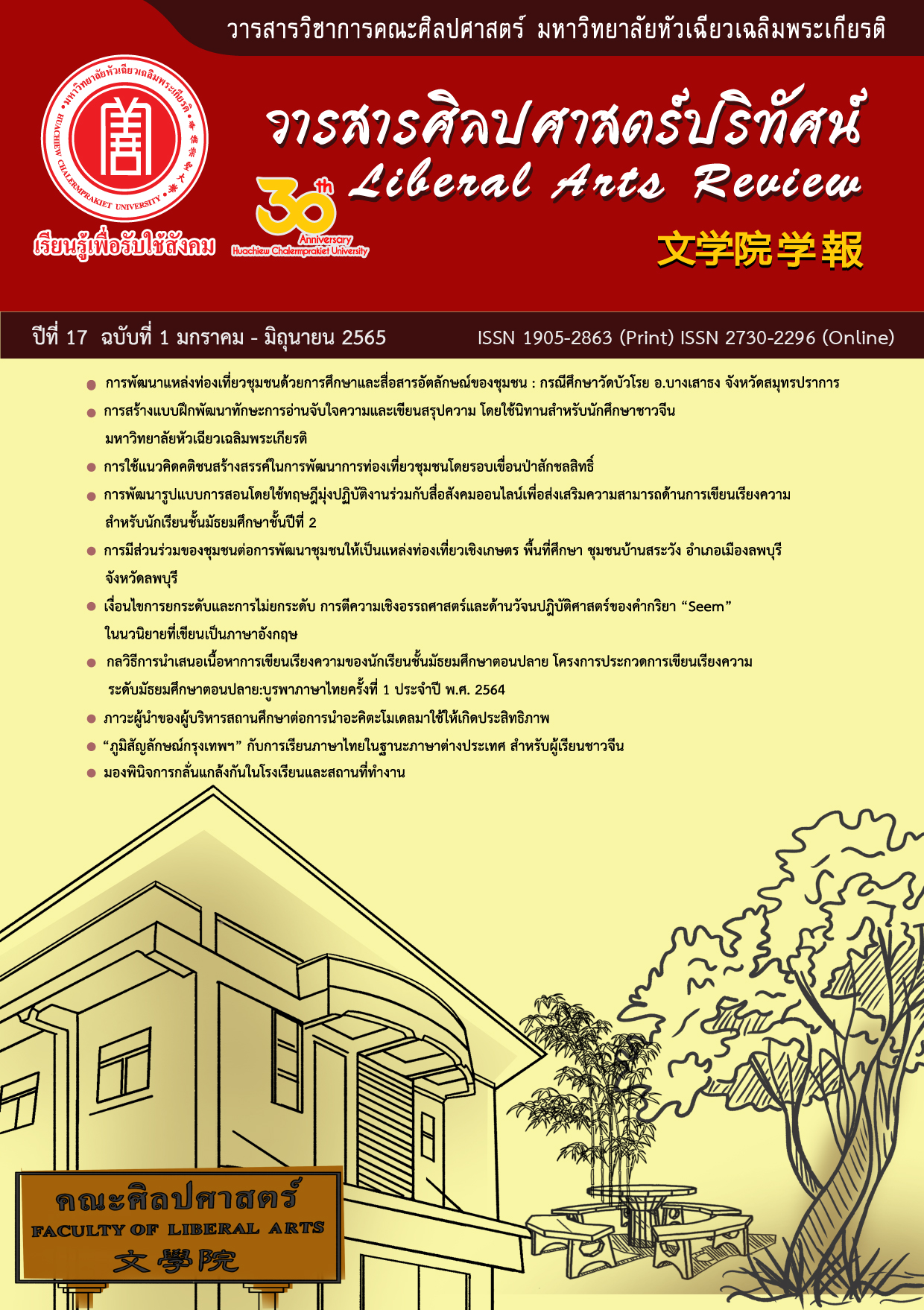Leadership of School Administrators Towards Effective Implementation of the Akita Model.
DOI:
https://doi.org/10.14456/lar.2022.8Keywords:
Leadership, School Administrators, Akita Model, Active-LearningAbstract
This article aims to present the leadership concepts of school administrators in implementing the Akita Model effectively, which are: 1) Have a vision and knowledge of the Akita Model to be conveyed to the team in detail and correctly in terms of philosophy, concepts, principles, nature of learners, teaching methods and processes measurement and evaluation and good practices from educational institutions that have performed effective; 2) Induce and create a positive attitude towards teaching the Akita Model to teachers to adjust the role of students as learning leaders, set clear goals, stimulate and motivate learners to have fun and have their own ideas; 3) Build an effective team of teachers by encouraging them to collaborate in teaching in one style and direction; 4) Educating and practicing Akita Model teaching skills for teachers to understand participatory learning management for both teachers. family and community; 5) Understanding parents and communities, create interactions, convey and disseminate principles, concepts, and active teaching approaches. to see that the school belongs to the commons of parents and the community; 6) Create a system to promote and motivate the teaching team by setting a policy. packaged in plans have a clear goal allocate supporting resources, designate active teaching management as a measure of operator success and part of performance evaluation; 7) Driving active teaching and continuous development; And 8) Create an open atmosphere, build morale and morale for the teaching team, provide care, give advice, give appreciation and encouragement, organize learning exchange activities and reward.
References
กฤติเดช สุขสาร. (2562). การประยุกต์ใช้การสอนเชิงรุกอาคีตะโมเดลในโรงเรียนประถมศึกษา. วารสารสมาคมพัฒนาวิชาชีพการบริหารการศึกษาแห่งประเทศไทย, 1(4), 18-23.
จรีพร โชติพิบูลย์ทรัพย์. (2559). การสร้างทีมงานที่มีประสิทธิภาพ. สำนักงานคณะกรรมการข้าราชการพลเรือน. (หนังสืออิเล็กทรอนิกส์). ค้นคืนจาก http://personnel.labour.go.th.
เฉลิมชัย มนูเสวต. (2561). Akita Action สอนให้เด็กคิดเป็น เติบโตอย่างมีคุณภาพ. ค้นคืนจาก https://so04.tci thaijo.org/index.php/JAPDEAT/issue/view/16960.
ชวลิต ชูกำแพง. (2561). การจัดการเรียนรู้เชิงรุกตามแนวอคิตะ (AKITA Action). วารสารเทคโนโลยีและสื่อสารการศึกษา. 1(4), 18-23.
ชูชัย สมิทธิไกร. (2557). จิตวิทยาอุตสาหกรรมและองค์การ. (พิมพ์ครั้งที่ 2). กรุงเทพมหานคร: สำนักพิมพ์แห่งจุฬาลงกรณ์มหาวิทยาลัย.
ธร สุนทรายุทธม. (2553). การบริหารจัดการเชิงจิตวิทยา: หลักการ การประยุกต์ และกรณีศึกษา. กรุงเทพมหานคร: เนติกุลการพิมพ์.
ธีระ รุญเจริญ. (2560). การศึกษาเรียนรู้ยุคดิจิทัล. เอกสารประมวลองค์ความรู้ประกอบการศึกษาหลักสูตรครุศาสตร์ดุษฎีบัณฑิต มหาวิทยาลัยราชภัฏอุบลราชธานี. (อัดสำเนา)
พนิตา อุสายพันธ์. (2562). “อะคิตะโมเดล” เคลื่อนปฏิรูปชั้นเรียนไทย. หนังสือพิมพ์เดลินิวส์การศึกษา. ค้นคืนจาก https://d.dailynews.co.th
ไพฑูรย์ สินลารัตน์. (2561). จำเป็นต้องปฏิรังสรรค์การศึกษาไทย (พิมพ์ครั้งที่ 6). กรุงเทพมหานคร: สำนักพิมพ์แห่งจุฬาลงกรณ์มหาวิทยาลัย.
ไพฑูรย์ สินลารัตน์, เฉลิมชัย มนูเศวต, และวาสนา วิสฤดาภา. (2562). ความเป็นไปได้ในการประยุกต์ใช้การสอนเชิงรุกอาคีตะโมเดลในประเทศไทย.วารสารบัณฑิตศึกษา มหาวิทยาลัยราชภัฏวไลยอลงกรณ์ในพระบรมราชูปถัมภ์. 13(1), 92-106.
เบญจมาศ นิลกำแหง, เสาวนีย์ สิกขาบัณฑิต, และกาญจนา บุญภักดิ์. (2564). “รูปแบบการพัฒนาทีมงานที่มีประสิทธิภาพในสถานศึกษาสังกัดสำนักงานเขตพื้นที่การศึกษาประถมศึกษาสมุทรปราการ เขต 2”. วารสารสังคมศาสตร์และมานุษยวิทยาเชิงพุทธ. 6(8), 218-235.
ยุวดี อยู่สบาย และ ศิรินยา พิพัฒน์ศรีสวัสดิ์. (2562). “การจัดการเรียนรู้แบบอะคิตะโมเดล”.วารสารพัฒนาเทคนิคศึกษา มหาวิทยาลัยเทคโนนโลยีพระจอมเกล้าพระนครเหนือ. 112, 3-16.
รัตนา แสงบัวเผื่อน. (2562). “อะคิตะโมเดล” เคลื่อนปฏิรูปชั้นเรียนไทย. หนังสือพิมพ์เดลินิวส์การศึกษา. (ออนไลน์) (อ้างเมื่อ 22 มกราคม 2565). จาก https://d.dailynews.co.th.
วิโรจน์ สารรัตนะ. (2555). แนวคิด ทฤษฎี และประเด็นเพื่อการบริหารทางการศึกษา (พิมพ์ครั้งที่ 8). กรุงเทพมหานคร: ทิพยวิสุทธิ์.
สุภัทร จำปาทอง. (2562). “อะคิตะโมเดล” เคลื่อนปฏิรูปชั้นเรียนไทย. หนังสือพิมพ์เดลินิวส์การศึกษา. ค้นคืนจาก https://d.dailynews.co.th.
สุภาพร พิมพ์บุษผา. (2561). การพัฒนาการจัดกิจกรรมการเรียนรู้ เรื่องสมการเชิงเส้นตัวแปรเดียว ชั้นมัธยมศึกษาปีที่ 1 โดยประยุกต์ใช้วิธีการสอนเชิงรุกของจังหวัดอะคิตะ(Akita Action). วารสารออนไลน์บัณฑิตศึกษา คณะศึกษาศาสตร์ มหาวิทยาลัยรามคำแหง, No.10, 1. ค้นคืนจาก http://www.edu-journal.ru.ac.th.
สำนักงานเลขาธิการสภาการศึกษา. (2560). แผนการศึกษาแห่งชาติ พ.ศ. 2560 – 2579. กรุงเทพมหานคร: พริกหวานกราฟฟิค.
สำนักงานเลขาธิการสภาการศึกษา. (2561). การจัดการเรียนรู้รูปแบบอะคิตะโมเดล “AKITA MODEL” โดยประยุกต์ใช้วิธีการสอนเชิงรุกของจังหวัดอะคิตะ ประเทศญี่ปุ่น (Akita Action). กรุงเทพมหานคร: สภาการศึกษา.
Caldwell, B. (2000). A Blueprint of Successful Leadership in an Era of Globalization in Learning. Paper Presented in a Regional Seminar of Leaders in Rajabhat Institutes, Rajabhat Institute Chombung, 10 November 2000. Ratchaburi: Rajabhat Institute.
Lambert, L. (2003). Shifting Conceptions of Leadership: Toward a Redefinition of leadership for the Twenty-First Century. In B. Davies and J. West-Burnham (Eds.), Handbook of Educational Leadership and Management. London: Longman. Chapter 1.
Northouse, P. G. (2017). Leadership Theory and Practice, 2nd edition. California: Sage Publications. Inc.
Downloads
Published
How to Cite
Issue
Section
License
Copyright (c) 2022 Liberal Arts Review

This work is licensed under a Creative Commons Attribution-NonCommercial-NoDerivatives 4.0 International License.
บทความที่ได้รับการตีพิมพ์เป็นลิขสิทธิ์ของวารสารศิลปศาสตร์วิชาการและวิจัย
ข้อความที่ปรากฏในบทความแต่ละเรื่องในวารสารวิชาการเล่มนี้เป็นความคิดเห็นส่วนตัวของผู้เขียนแต่ละท่านไม่เกี่ยวข้องกับมหาวิทยาลัยหัวเฉียวเฉลิมพระเกียรติ และคณาจารย์ท่านอื่นๆ ในมหาวิทยาลัยฯ แต่อย่างใด ความรับผิดชอบองค์ประกอบทั้งหมดของบทความแต่ละเรื่องเป็นของผู้เขียนแต่ละท่าน หากมีความผิดพลาดใดๆ ผู้เขียนแต่ละท่านจะรับผิดชอบบทความของตนเองแต่ผู้เดียว




